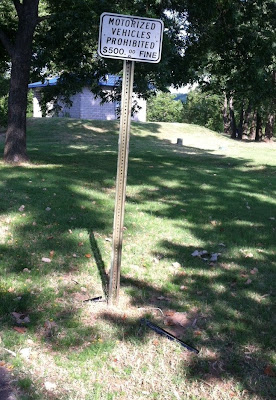I like to do most of my own work, so I've purchased tools as tasks have come up that required them. Many riders, quite sensibly, would rather just take the bike to their friendly LBS, but for small-towners that can be a ride breaking hassle, and many of us just like to be able to work on our own bikes.
At the very least, everybody needs:
Tire levers- they're dirt cheap. Keep in your flat kit. I also have a couple in my home tool kit.
Multitool- most multitools will have all the hex sizes you need, screw drivers, and a chain breaker. Good for the seat bag and emergencies. Most are clumsy to use, but actually having the right tool out on the road is a small trade for fumbling a bit.
After that:
Hex wrenches- a multi-tool will serve, but you can buy a set of cheapies for $5.00.
I finally broke down and bought a nice ball-end, T-handle set, and they were worth the 30.00. Hex wrenches are used for almost every fastener on the bike, so you use them a lot. They're first on the list for a reason.
Work Stand- A work stand provides a stable platform for your bike while allowing you to turn the cranks and operate the shifters. Even cleaning your bike is a bit of a pain in the ass without a work stand, so if you don't have one, put it on your Christmas list. You can buy a stand for under $50.00, but a decent work stand will cost north of $100.00 and a really good one is typically $200.00-300.00. You can often find bargains on a good stand shopping on line, but always give your local bike shop a shot at your business first
Cleaning brushes and rags- a clean bike works more reliably and cleaning you bike gives you a good chance of finding damaged or worn parts before a failure leaves you on the side of the road.
If I lived 50 miles from a bike shop, I'd also have the following:
Chain tool- allows you to press out and insert pins to remove and assemble a chain. Chains are reliable, but a broken chain means no ride if you don't have a back-up plan. Chains are "wear" items like tires and I always keep a spare on hand. Replacing chains before they wear out saves on more expensive cassettes. See how to check for chain using a ruler wear here, or you can buy this simple tool from Park. There are several tools available for this purpose, but simple and cheap works fine here.
Chain Whip- This unique tool is used to remove a cassette from the hub body of your rear wheel. It is a long-handled tool with chain attached to engage a cog on the cassette as your loosen the cassette lock nut. It is a necessary tool for the home bike mechanic and, as an aside, use of the term "chain whip" in casual conversation is sure to grab the attention of listeners.
Chain whip with cassette locknut tool and a pedal wrench.
Pedal Wrench- Most pedals have a hex socket accessible through the bike side of the crank; however, it often takes some torque to remove a pedal. All pedals have a 15mm wrench flat on the spindle adjacent to the crank arm. Pedal wrenches have an open-ended 15mm fairly thin head, are long-handled, and are built in a manner that would make them a formidable weapon. If I'm ever jumped by ninjas in the bike shop, I'm grabbing a pedal wrench. If you have one bike, you may never need this tool, but we have a few bikes, sometimes need to throw on some flat pedals for guests or take pedals for a rental or demo. It's a tool that you'll never wear out or break and that will do its job without scratching up your crank as you are likely to do using standard tools.
Cable and Housing Cutter- while it may seem that a wire cutter would do the job of cutting shifter and brake cables, they're generally not up to the task. Cables, particularly shifter cables, do eventually fail, and it is convenient to be able to replace then on your own. Of course, that means that you also need to have a cable and the confidence to adjust your derailleur or brake after installation.
My tool selection also includes a torque wrench and bottom bracket tools. Bar tape and a chain are good to have on hand.
The proliferation of carbon parts and frames make a torque wrench a desirable addition. Crack a carbon seat post and you've spent enough to buy a pretty good tool set.
Bottom bracket "standards" have gone crazy. I put "standards" in quotation marks because in recent years we've gone from standard English or Italian threaded BB's to BB30, BBRight, BB90, BB95, PF86/92, PF30, etc, etc. The result is a lot of confusion over crank and frame compatibility and some system-specific tools. Most bikes made up until a few years ago had English threaded BB shells and installation and removal of the BB was fairly simple.
If you're of a curious nature, you can let your head swim here in an in-depth article on the topic. My new frame has a PF30 BB and I am resigned to visiting my local bike shop should it need work. I'm holding off on buying new BB tools until I need them and have a better grasp of servicing the system.
Parts and Supplies
It is a good idea to keep consumable parts on hand and to learn the basic skills to install them. I always have a stock of extra tires and tubes, bar tape, a couple of brake and shifter cables, and a chain on hand, along with lube, grease, and cleaning supplies. Tubes are a no brainer. Tires are a good idea. A couple of weeks after I got my now old Cannondale, I tore a sidewall on a Saturday afternoon, resulting in a phone call and a mad dash to the bike shop at closing time for a new tire to salvage my planned Sunday ride, so I started keeping an extra tire. The same goes for cables and a chain. Bar tape emergencies rarely arise, but fresh bar tape is just plain nice and it's something that can be done on a whim if you have tape on hand.
You will eventually use these things, so I advise buying them at your convenience rather than scrambling around the night before a big ride.
Most riders have no interest in being a bike mechanic, but folks with a basic mechanical aptitude can easily learn some of routine jobs required to keep your steed in good running order. Beyond fixing a flat I would urge you to learn common tasks to include minor derailleur adjustment, wrapping bars, and replacing the chain and cables. Youtube is a fantastic resource for learning almost anything and you will find easy-to-follow tutorials on each of these jobs. And, when all else fails, your bike shop guy will be entertained when you bring in your torn-down bike and box of parts. I suggest that there be a 6-pack in the box if this step is required.





























